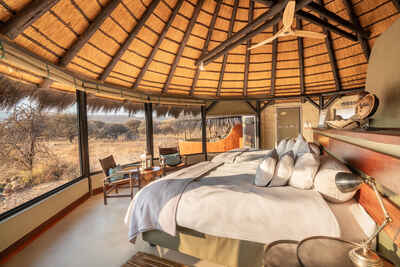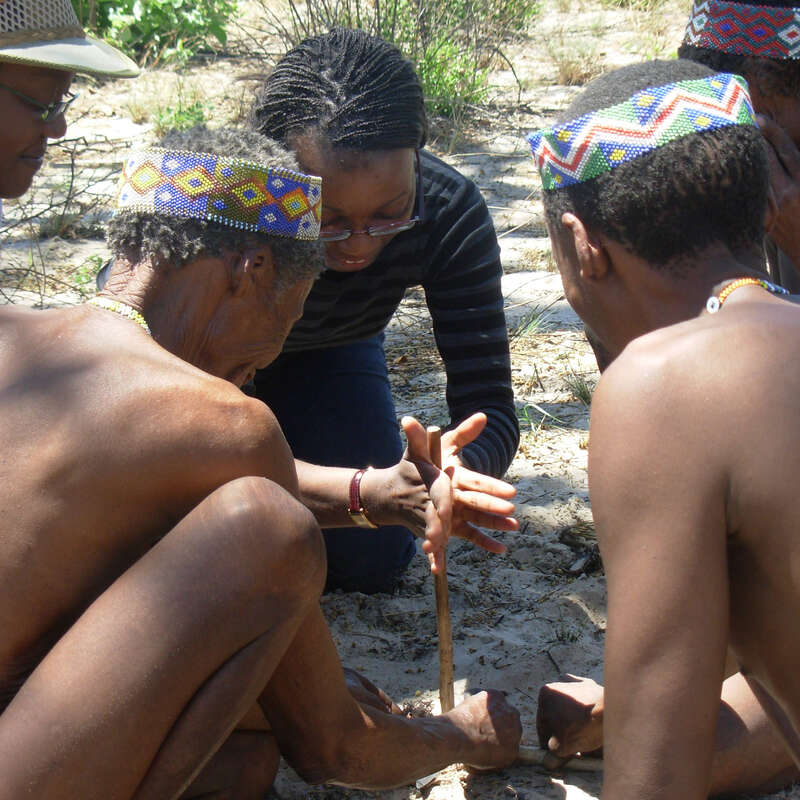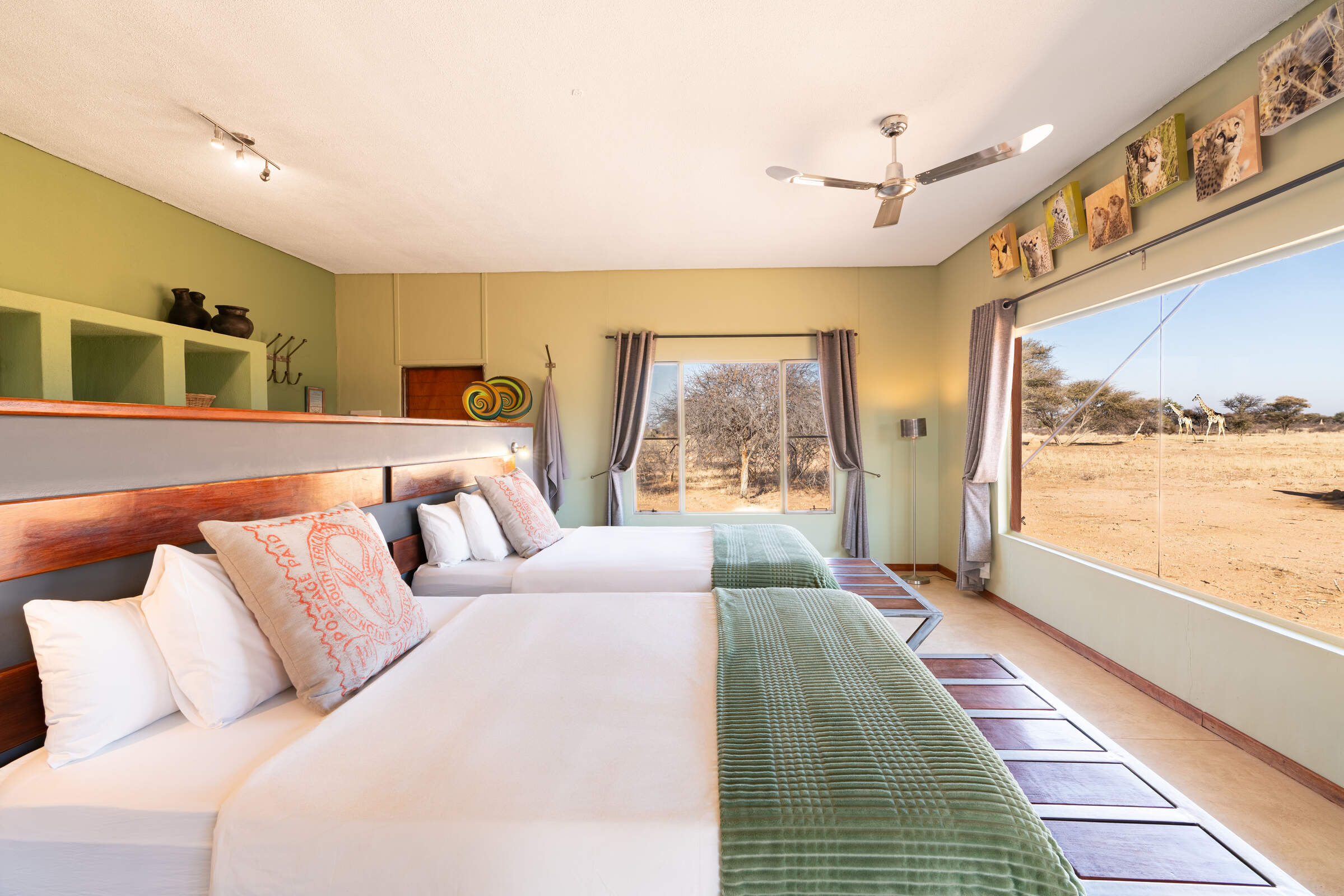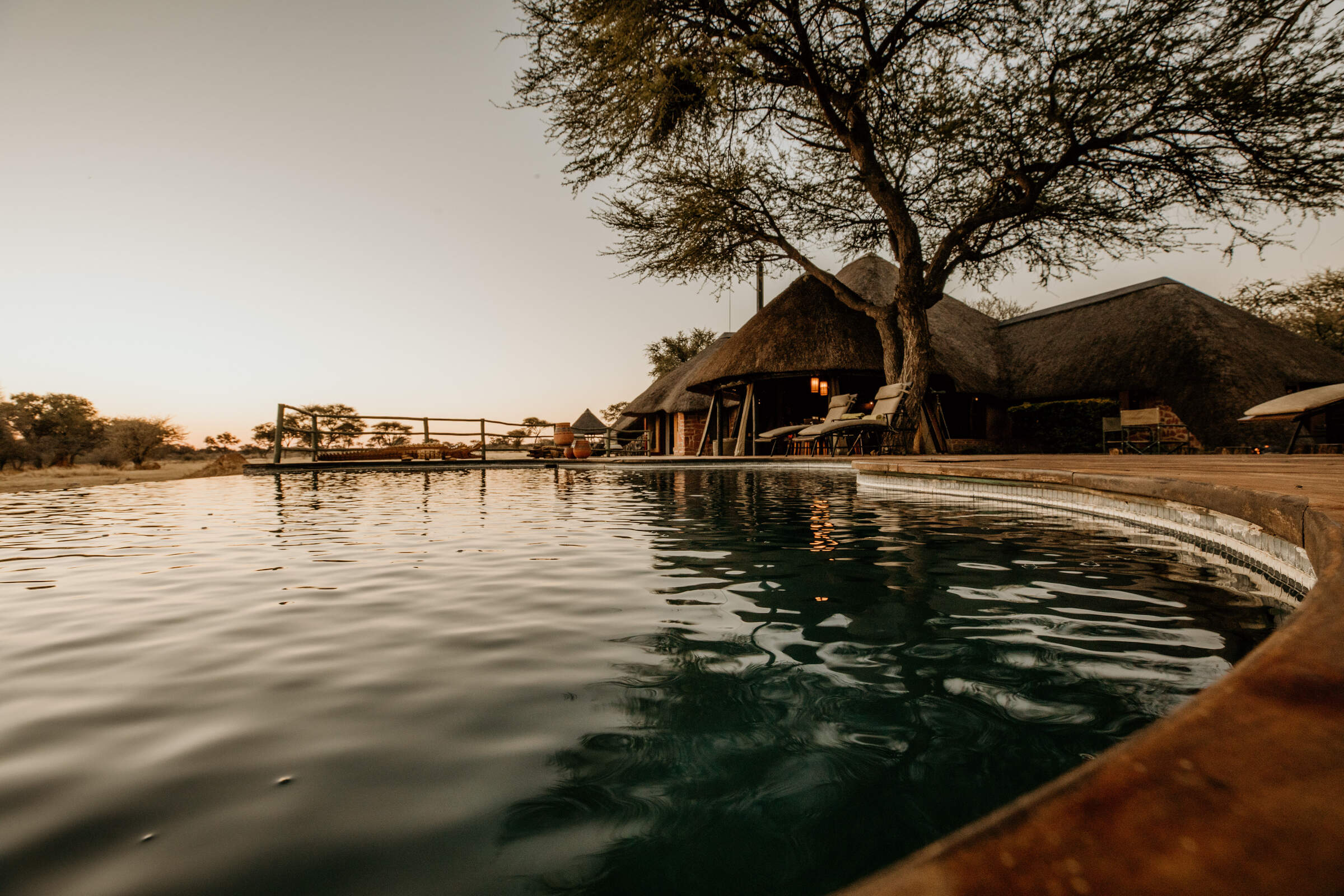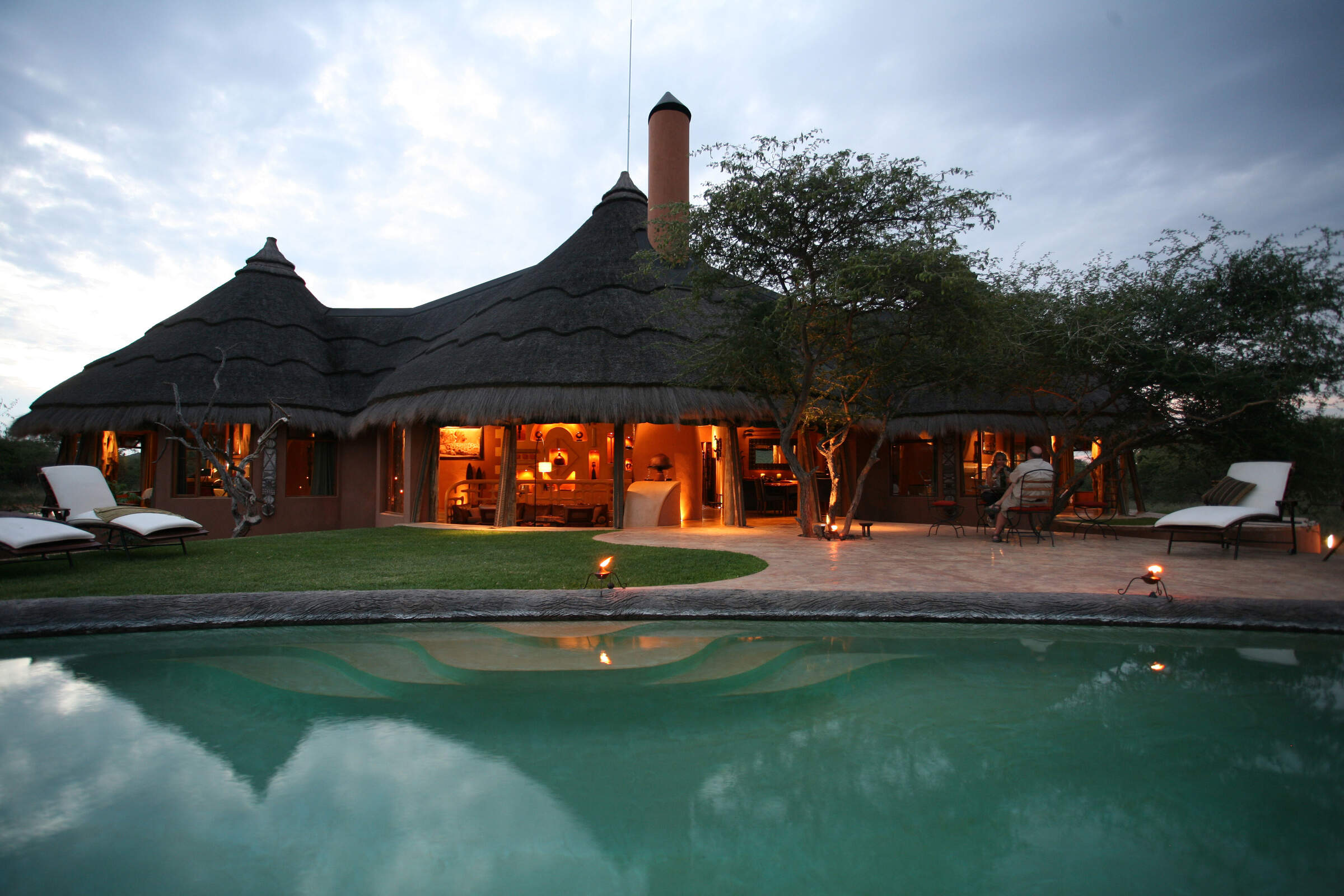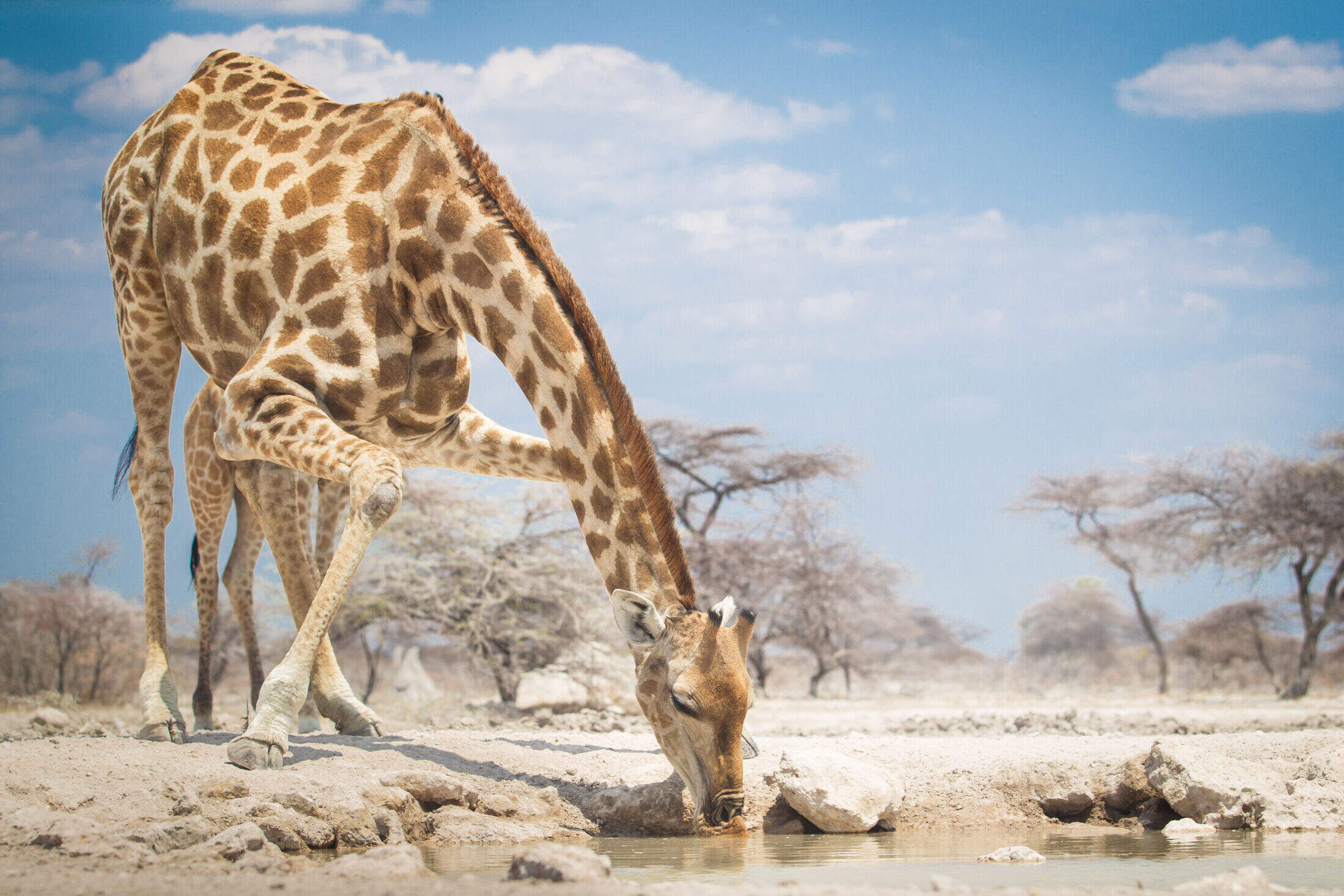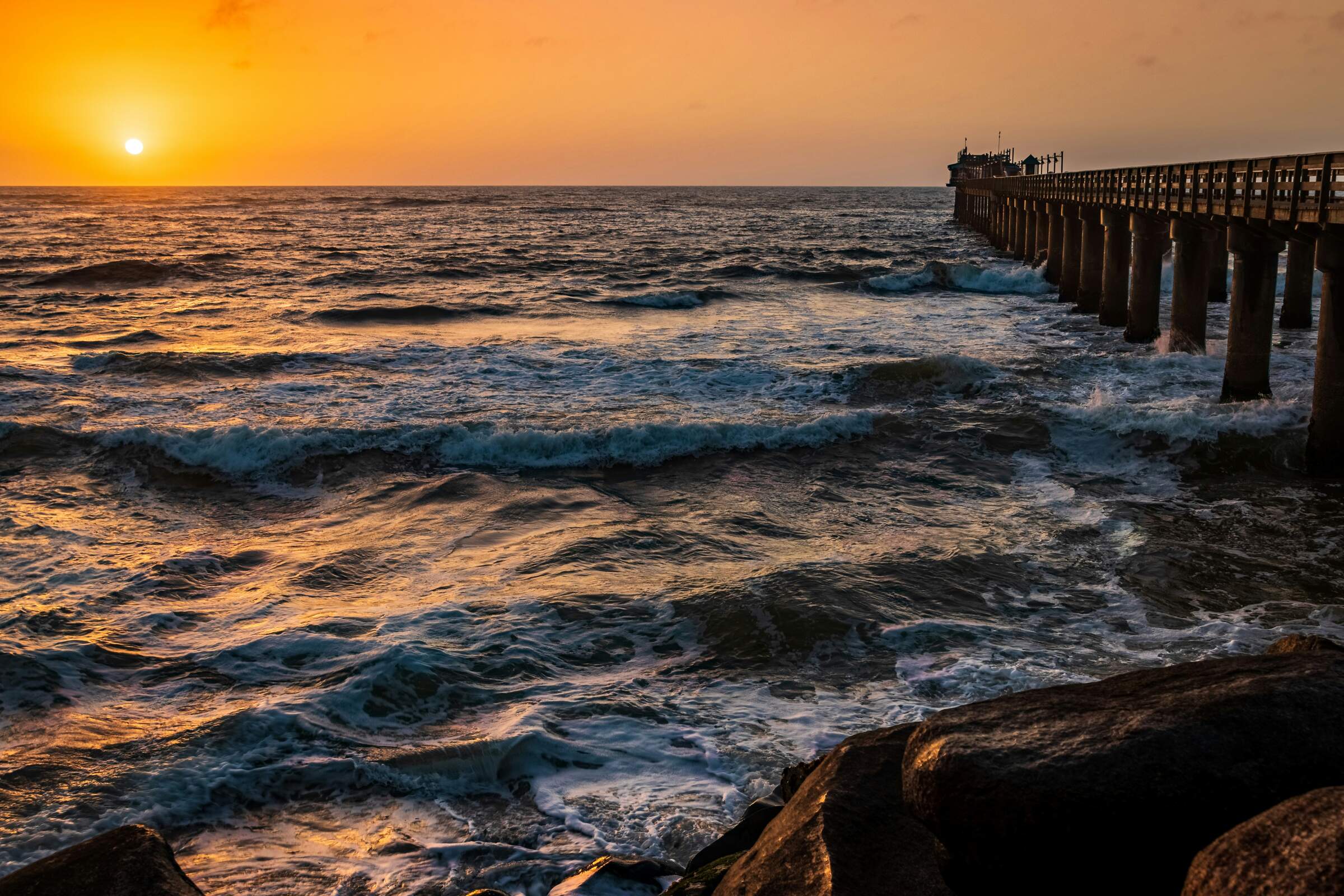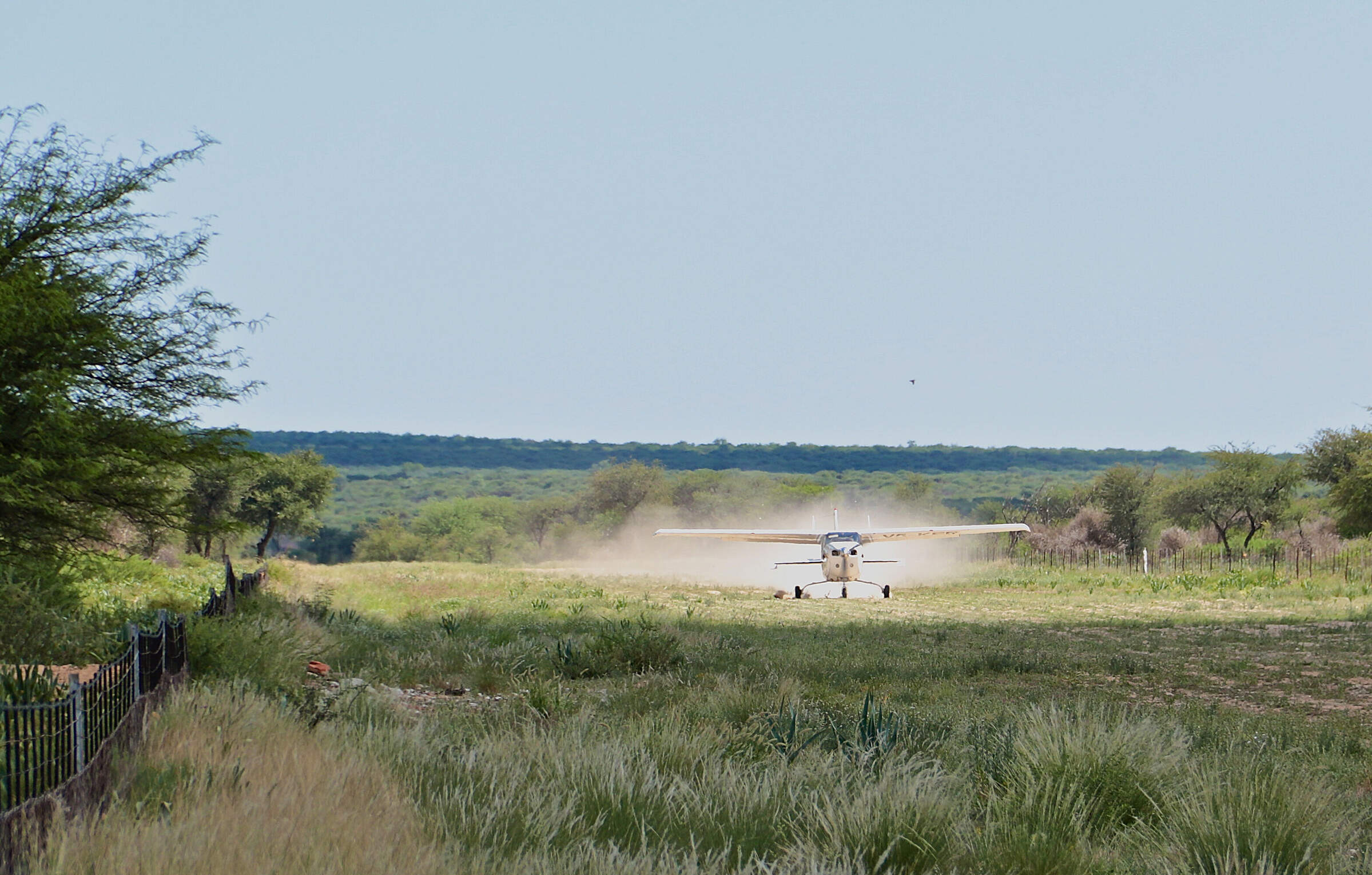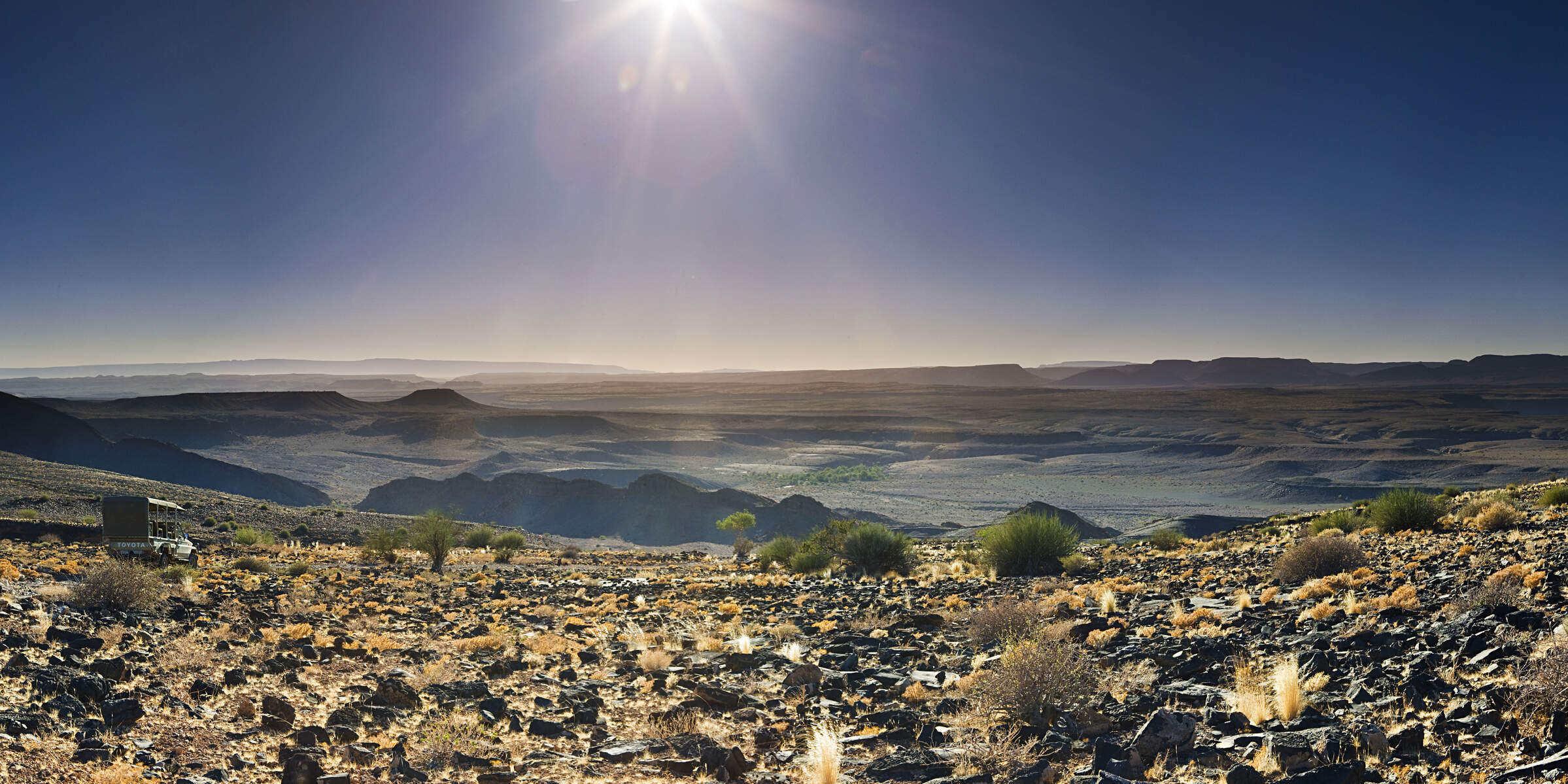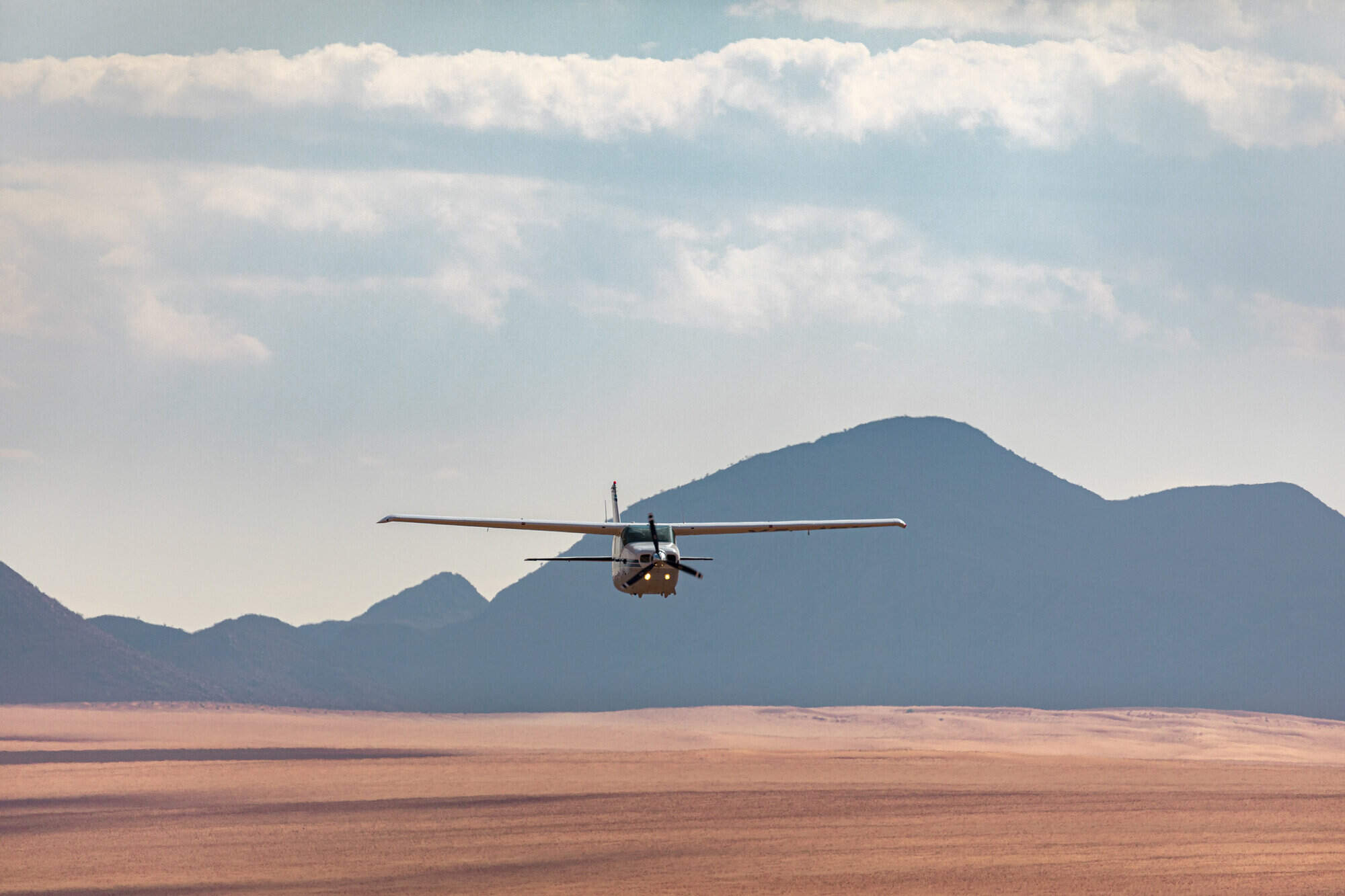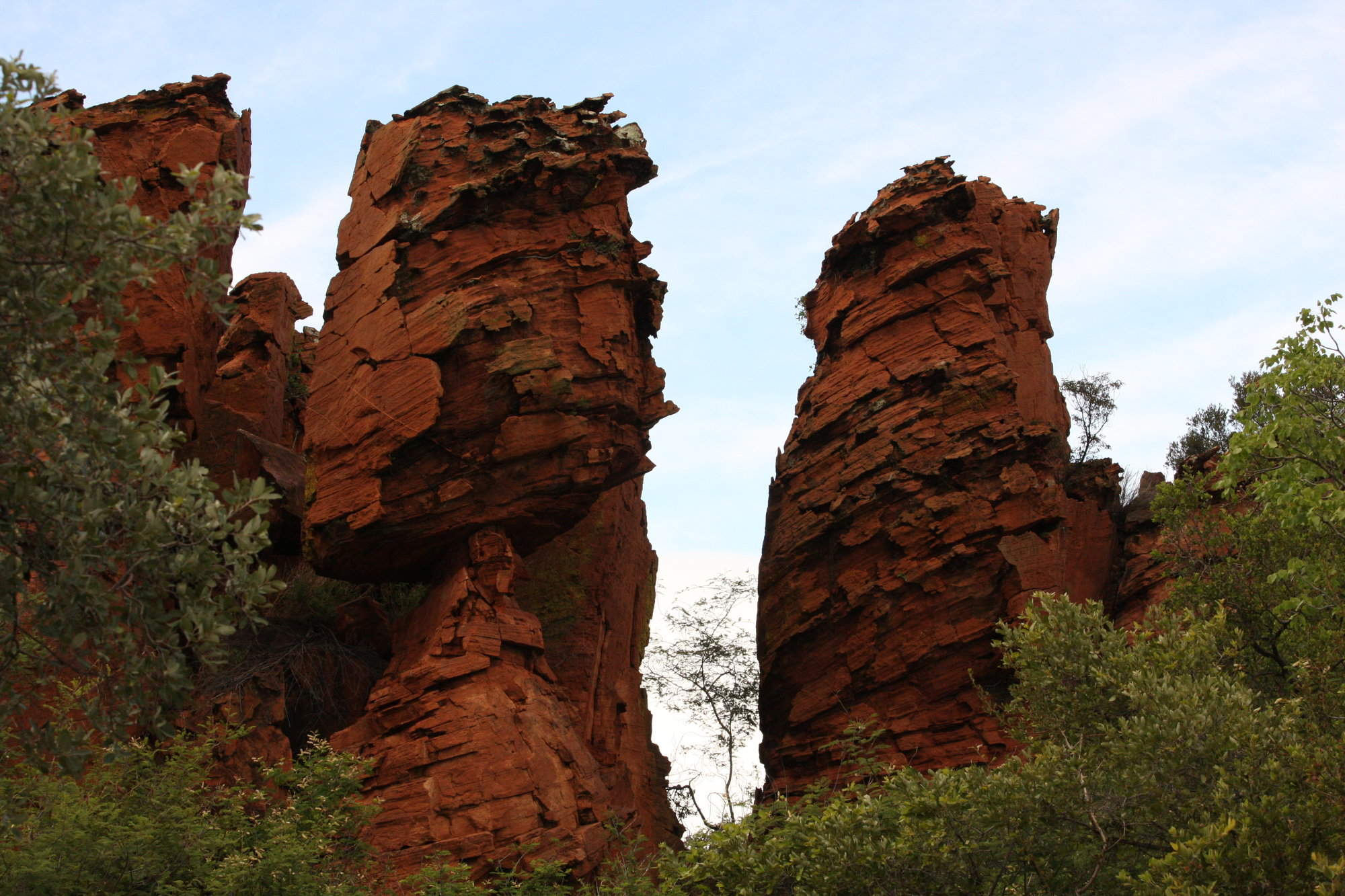Okonjima Bush Camp: Our full report
The rolling hills and grassy plains of the Okonjima Nature Reserve are home to Okonjima Bush Camp.
The 220km² reserve, just south of Otjiwarongo, is also the base for the AfriCat Foundation, a non-profit organisation set up to conserve and protect Namibia's wildlife – with a focus on carnivores. From this small camp, guests are invited to learn about human-wildlife conflict and to get up close to some of the country’s endangered species, especially the elusive leopard.Bush Camp, along with its sister camps on the same large reserve – the bigger Okonjima Plains Camp, and, the two-bedroom Bush Suite, is located within a 20km² fenced “wilderness” area of the Okonjima Reserve. While there are antelope, warthog and giraffe within this fenced area, most larger predators have been moved elsewhere in the reserve, so it is deemed safe for guests to walk around the lodge unescorted. The only property located in the main reserve is the luxurious, four-bedroom, private Okonjima Villa, which overlooks a large waterhole.
Bush CaBush Camp, along with its sister camps on the same large reserve – the bigger Okonjima Plains Camp, and the two-bedroom Bush Suite, is located within a 20km² fenced “wilderness” area of the Okonjima Reserve. While there are antelope, warthog and giraffe within this fenced area, most larger predators have been moved elsewhere in the reserve, so it is deemed safe for guests to walk around the lodge unescorted. The only property located in the main reserve is the luxurious, four-bedroom, private Okonjima Villa, which overlooks a large waterhole.
Bush Camp has just eight chalets and a honeymoon suite, each constructed of clay. Spaced 80–100m apart, for privacy, the chalets are styled on traditional circular African dwellings, or rondavels, with conical thatched roofs. Large glass windows to the front let in plenty of light and afford terrific 180° views of the grassy plains from your bed.
The rooms, with two queen-size beds, are simply decorated in a warm cream colour, enlivened by carvings and artefacts. A sculpted partition wall separates the bedroom from the en-suite bathroom, which has a shower, twin stone sinks and separate toilet. Each room is also equipped with a ceiling fan, a small safe, a hairdryer, insect repellent and a telephone linked with both reception and the other chalets.
Adjacent to each chalet is a separate open-sided rondavel that serves as a lounge area and is furnished with very comfortable day beds: the perfect shady spot to relax in the heat of the day. Welcome refreshments are close to hand in the form of tea/coffee-making facilities and a jar of delicious freshly baked biscuits; there is also a minibar that is stocked on request. In front of each chalet is a small bird bath/waterhole where smaller antelopes, warthogs, birds and mongooses come to drink. As an additional touch, a jar of birdseed is provided for you to scatter to attract a variety of birds. On one of our visits, we got some great close-up pictures of guinea fowl, waxbills, francolin and hornbills when we tried it!
With similar amenities, but quite different in design, the honeymoon suite is a rectangular room with large sliding-glass doors in front of the bed. It also differs in that there is a fireplace in the lounge, as well as a bathtub and an outdoor shower.
The main area at Okonjima Bush Camp is one of our favourite parts of the camp. A large, curved building, it overlooks a manicured lawn with a pond, and grassy plains beyond. It has three quite distinct areas: the reception and a curio shop; a dining room with beautiful, heavy wooden tables; and a large and very inviting lounge with a fireplace and the bar. There is almost always a member of the team around if you need anything and, on our visits, nothing has seemed too much trouble. Around the side of the building, and slightly raised, is a decent-size swimming pool, with sunloungers and shaded areas to relax out of the sun.
As with its sibling properties at Okonjima, Bush Camp is perhaps best known for its leopard tracking. A stay here of one or – better – two nights will usually give you the chance to track and observe these often elusive big cats at close range. As an added bonus, the cats are used to seeing people so are generally relaxed around the vehicles, providing some excellent photographic opportunities (although note that most of the leopards are collared for research purposes). Although sightings can never be guaranteed, on our last visit in April 2024 we were lucky to spend around an hour and a half watching a female leopard and her young sub-adult cub up a tree, eating a giraffe carcass they had killed the night before.
In addition to leopard tracking, other activities led by the knowledgeable guides at Okonjima include:
- Nature drives: There are over 40 mammal species on the reserve and many more birds. Guests will see many of these while out tracking leopard or other species, but if you stay more than a night or two you can choose to go out without using tracking telemetry and see what you can find.
- Pangolin tracking: This activity has limited availability and is weather dependent. Departing after dark, guests have the opportunity to track tagged ground pangolin, following it at a discreet distance on foot. Good footwear and a flashlight are required. Pangolins spend much of their time underground so even with tracked individuals sightings are not guaranteed.
- Rhino tracking: Okonjima is home to a small population of southern white rhino that are constantly monitored by the reserve's anti-poaching team. On this activity, guests can often approach the rhino on foot.
- AfriCat Carnivore Care Centre: Here guests may visit some of the reserve's welfare animals – individuals that cannot be released into the wild. These animals help with education and provide an insight into the work of the AfriCat Foundation. After visiting the welfare animals you'll head to the information centre to learn about the history of Okonjima and their ongoing work.
- Night drive: As many of Namibia's animals are exclusively nocturnal, this activity offers the chance to head out into the bush after dinner to try and find species that you'd usually miss during the day.
- Night hide: This activity is exclusive to Bush Camp guests. Head out to the hide after dark to see what wildlife passes by.
- Self-guided walking trails: For those who'd like a break from bumping around in a vehicle and would like to stretch their legs, there are several well-marked walking trails within the fenced wilderness area. These offer the chance to look at the smaller things and to spot some of the reserve's many bird species.
Our view
Okonjima Bush Camp's small size, as well as the generally high standards of care, attentive service and delicious food, create a very comfortable and exclusive-feeling environment. Over many visits, the camp's knowledgeable guides have also made it highly memorable. We've returned home with a wealth of information about Namibia's carnivores, and some fantastic photographs of leopard in particular.
Geographics
- Location
- Okonjima Nature Reserve, Namibia
- Ideal length of stay
- At least two nights are best to enjoy the reserve’s wildlife. However, if you are limited for time, on a one-night stay you should be able to get an idea of what the AfriCat Foundation does, and with luck see some cats.
- Directions
- Okonjima Bush Camp lies some 23km west of the B1, about 48km south of Otjiwarongo.
- Accessible by
- Self-drive or Fly-and-Transfer
Food & drink
- Usual board basis
- Full Board & Activities
- Food quality
- In our experience, Okonjoma Bush Camp has always put thought and effort into its food. We were pleased to see this was still the case when we visited in April 2024, when the food here was some of the best on our trip.
A light breakfast is on offer for those going out on a morning activity. It's an early start, so it's normally a small selection of cereals, muffins, fruit, tea and coffee. On your return, a much larger breakfast buffet, consists of the usual selection of bread, toast, muffins, cereals, yoghurt, fruit, juice, cold meat and cheeses, as well as a hot breakfast with bacon and eggs cooked to order.
On our most recent one-night stay we didn't have time for lunch, but this is usually quite informal and maybe a salad or light meal.
Afternoon tea is served before the afternoon activity departs; on our visit, this included vegetable pastries and a delicious carrot cake.
Dinner is a three-course plated meal. We enjoyed butternut, courgette and feta fritters with feta cream, pumpkin seed pesto and butternut crisps to start. For main we had a choice of chicken or beef kebab served with pumpkin and rosemary mielie pap, flash-fried vegetables, a mushroom jus and beetroot marmalade; the beef was perfectly done. Finally, dessert was a superb date and toffee pudding with caramelised banana, toffee sauce and vanilla ice cream - Dining style
- Mixture of group dining and individual tables
- Dining locations
- Indoor and Outdoor Dining
- Further dining info, including room service
- No
- Drinks included
- Bottled water, soft drinks, local beers and spirits and a limited selection of house wines are included. Champagne and imported wines and spirits will cost extra.
Special interests
- Honeymoons
- Each of the large, luxuriously appointed chalets at Okonjima Bush Camp comes with its own separate day room: perfect for a Namibian honeymoon. For something extra special, consider the larger honeymoon suite, with its own fireplace, bathtub and outdoor shower.
- See ideas for Honeymoons in Namibia
- Birdwatching
- For birdwatching in Namibia, the guided and self-guided walks around Okonjima can be excellent. The lodge itself also has a variety of watering points, bird-baths, dams and lakes that help to attract the local birdlife.
- See ideas for Birdwatching in Namibia
- Photography holidays
- For close-up shots of predators, especially leopard, Okonjima deserves to be high on the list for photographers in Namibia. Allow at least two days to maximise your photographic chances, and do be aware that most of the big cats are collared
- See ideas for Photography holidays in Namibia
- Wildlife safaris
- Visitors at Okonjima can usually have the chance to view big cats at much closer quarters than is possible in most national parks. With most of the animals habituated to humans, this is a good place to end a wildlife safari in Namibia.
- See ideas for Wildlife safaris in Namibia
- Luxury
- Okonjima Bush Camp's interior encompasses lovely African artefacts and carvings, while the en-suite bathrooms feature stylish stone washbasins and large walk-in showers. Highly attentive service and delicious food enhance its reputation as a luxurious Namibian safari lodge.
- See ideas for Luxury in Namibia
Children
- Attitude towards children
- Okonjima Bush Camp welcomes well-behaved children over the age of 12 years.
- Property’s age restrictions
- Bush Camp has a minimum age limit of 12 years. Activities that involve walking in the reserve are only available to those over 14 years old.
- Special activities & services
- None
- Equipment
- None
- Generally recommended for children
- Although we think that Bush Camp would be acceptable for children over the age of 12, they might feel more at ease at. Plains Camp, which is much more geared towards families. They are also much more likely to meet other children at Plains Camp.
- Notes
- Children must be under the constant supervision of their parents at all times. The pool is not fenced and despite the fence around what Okonjima term as the “safe zone” for the camps on the reserve, there is some wildlife (warthogs, antelope, zebra, giraffe etc) within the area.
Our travellers’ wildlife sightings from Okonjima Bush Camp
Since mid-2018, many of our travellers who stayed at Okonjima Bush Camp have kindly recorded their wildlife sightings and shared them with us. The results are below. Click an animal to see more, and here to see more on our methodology.

98% success

96% success

95% success

92% success

68% success

67% success

52% success

51% success

44% success

27% success

10% success

6% success
Communications
- Power supply notes
- There is a back-up generator in case the mains power fails. Each chalet has plug points, as well as a hairdryer, electric kettle and bar fridge.
- Communications
- There is cellphone reception in the rooms and in the main area. There are normally telephones in each of the rooms, with internal lines only. WiFi is available in each chalet as well as the main area.
- TV & radio
- None
- Water supply
- Borehole
- Water supply notes
- All rooms have showers and hand basins that are plumbed in, with flushing toilets. The honeymoon suite has a plumbed-in bathtub.
Sustainability
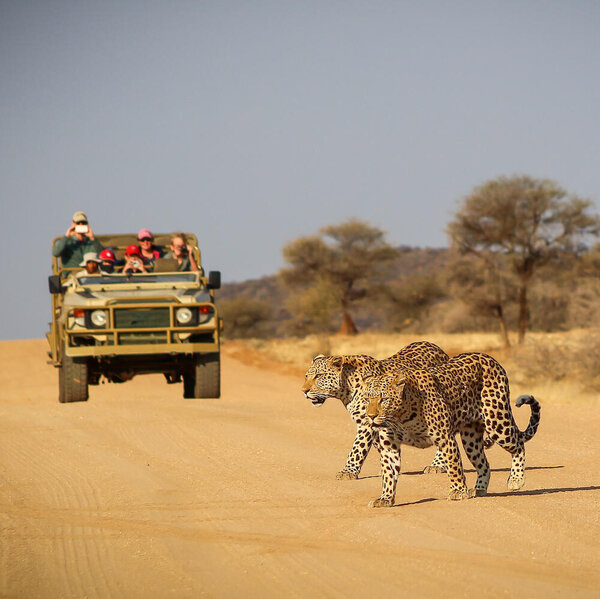
Conservation through education
At the heart of the Okonjima Reserve is the AfriCat Foundation, whose tagline today is “conservation through education”. Since its inception in the early 1990s, AfriCat’s primary focus has been to protect predator populations.
In order to achieve this, work starts with studying animal behaviour, and is currently looking at brown hyena and leopard populations to understand how their behaviour changes and evolves over time. From here they go on to develop mitigation strategies for human-wildlife conflict and then, by promoting these to Namibia’s farmers, can start to protect the animals themselves.
See more great sustainability projects in Namibia
Health & safety
- Malarial protection recommended
- Yes
- Medical care
- The nearest doctor is in Otjiwarongo, about 40 minutes' drive from Okonjima. In a medical emergency, the camp can arrange for travellers to be flown to Windhoek.
- Dangerous animals
- Moderate Risk
- Security measures
- The whole reserve is fenced and there are guards at the main entrance gate.
- Fire safety
- There are fire extinguishers in each room and in the central areas.
Activities
4WD Safari
Birdwatching
Cultural excursion
Mountain biking
Night drive
Private activities
Self-guided walking
Extras
- Disabled access
- On Request
- Laundry facilities
- A full laundry service is included. Weather permitting, laundry collected in the morning will be returned the same day.
- Money
- Each room has a small safe for storing valuables. There are no currency-exchange facilities available.
- Accepted payment on location
- The camp accepts Visa or Mastercard credit and debit cards. Payments can also be made in cash with Namibian dollars and South African rand.
Other lodges in Okonjima Nature Reserve
Alternative places to stay in this same area.
